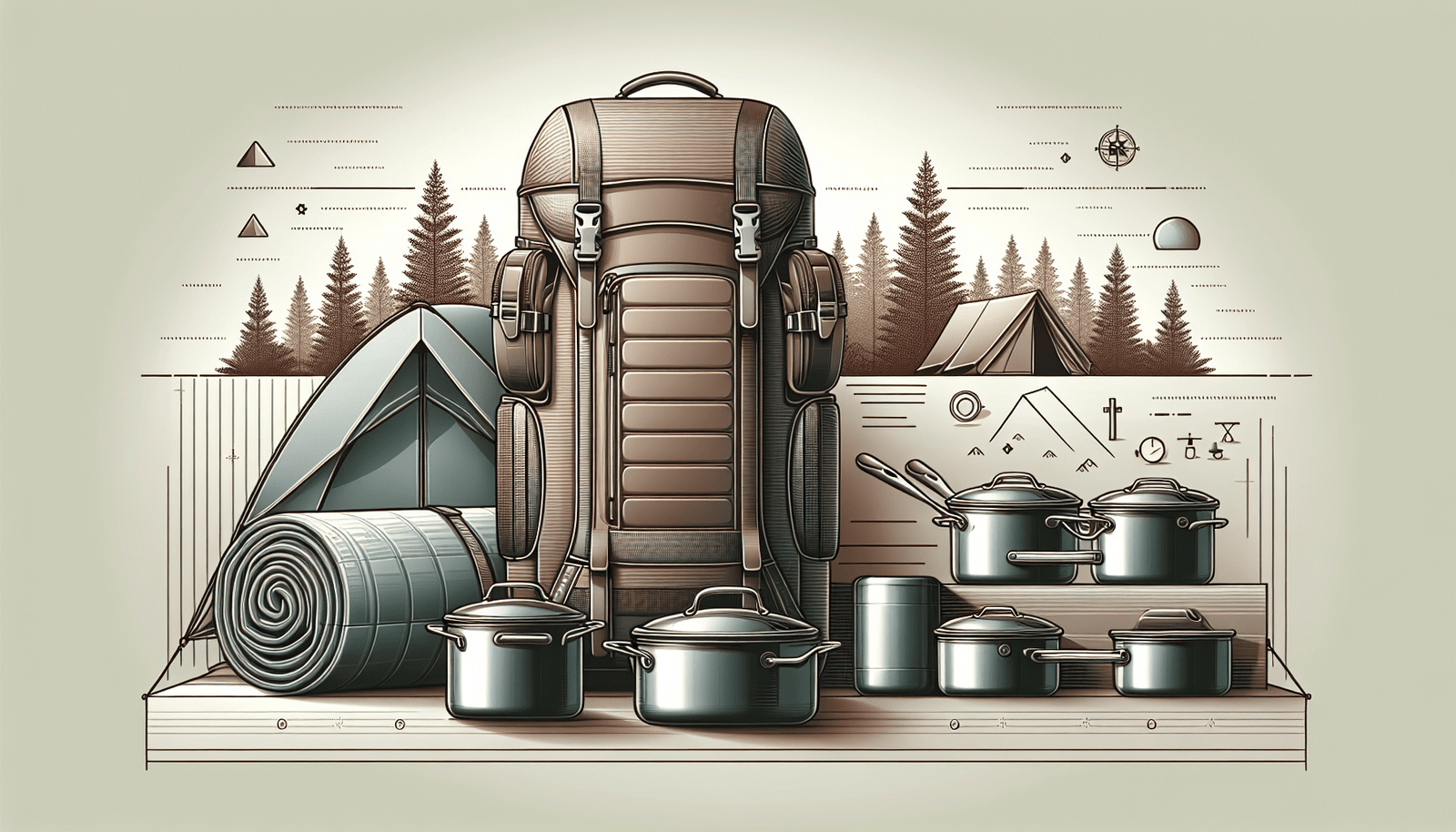Packing for a camping trip can be an exciting but sometimes challenging task, especially when it comes to ensuring you have all the right gear for cooking in the great outdoors. In the article “How Do You Pack Pots And Pans For Camping?”, you’ll discover practical and easy-to-follow tips to efficiently pack your pots and pans, ensuring they remain safe, organized, and ready for your culinary adventures. Whether you’re a seasoned camper or a newbie, these strategies will help streamline your packing process and elevate your outdoor cooking experience. Have you ever found yourself asking, “How do you pack pots and pans for camping?” Well, you’re in the right place! Learning how to efficiently pack your cookware is absolutely essential when preparing for a camping adventure. You want to ensure that everything is compact and organized, so you don’t end up frustrated when you should be enjoying the great outdoors.
Whether you’re a seasoned camper or a novice, having a systematic approach to packing your pots and pans can save you time, space, and a whole lot of headaches. So, let’s dive into practical tips and expert advice on how to pack your cookware effectively for your next camping trip!
The Importance of Packing Right
It might seem trivial at first, but how you pack your pots and pans for camping can make a big difference in your camping experience. It’s all about maximizing space while keeping your cookware safe and accessible.
Space Management
When you go camping, space is often at a premium. You want to ensure you have enough room for all your essentials, from sleeping bags to food supplies, while still keeping everything orderly.
Protection of Cookware
Your pots and pans can get knocked around quite a bit during travel. Proper packing can prevent dents, scratches, and other damage that could render your cookware unusable.
Accessibility
Having your cookware easily accessible means you can quickly set up your camp kitchen and get to the fun part – cooking delicious meals in nature’s wonderland!
Choosing the Right Cookware
Before we get into the nitty-gritty of packing, it’s essential to select the right cookware for your camping needs. Not all pots and pans are suitable for camping, and choosing the right type can make packing much easier.
Material Matters
The material of your pots and pans plays a significant role. Let’s look at some popular options:
| Material | Pros | Cons |
|---|---|---|
| Aluminum | Lightweight, heats up quickly | Can warp at high temperatures |
| Stainless Steel | Durable, rust-resistant | Heavier, slower to heat up |
| Cast Iron | Excellent for even heating | Very heavy, requires maintenance |
| Titanium | Ultra-light, corrosion-resistant | Expensive, can heat unevenly |
Multi-Purpose Cookware
Opt for pots and pans that can serve multiple functions. A pot that doubles as a bowl or a pan that can be used as a plate can save a lot of space.
Nesting Cookware
Nesting cookware sets are designed to save space by fitting together like a set of Russian dolls. This way, you bring all the cookware you need without taking up too much room.
Packing Techniques
Now that you’ve selected the appropriate cookware, let’s get into the actual packing process. There are a few tried-and-true methods to ensure your pots and pans are packed efficiently and securely.
Cleaning and Preparing
Before packing, make sure all your cookware is clean and dry. Any residual food or moisture can lead to unpleasant odors or even rust, especially on long trips.
Use Protective Layers
Place paper towels, dishcloths, or microfiber cloths between each pot and pan. This helps prevent scratches and other damage. Plus, these cloths can double as cleaning supplies once you’re at your campsite.
Employ the Nesting Method
If you have nesting cookware, make good use of it. Place smaller pots inside larger ones, and do the same with pans. This will save a significant amount of space.
Secure Loose Items
Use bungee cords or utility straps to secure loose items. This will keep everything in place, preventing your pots and pans from shifting and clanking around during your journey.
Pack Strategically
Place your heaviest cookware at the bottom of your pack or storage bin. This keeps the center of gravity low, making your gear easier to carry and reducing the risk of tipping.

Additional Packing Tips
Now that you have a good understanding of the basics, here are some additional tips to make your packing even more efficient.
Utilize Packing Cubes
Packing cubes aren’t just for clothes. You can use them to organize and compress your cookware too. Look for water-resistant cubes to protect your gear from any unexpected showers.
Consider Collapsible Cookware
Collapsible pots and pans can be a game-changer for those short on space. These items fold down flat, making them easy to pack away.
Use Carabiners
Attach smaller items like utensils, lids, or even a collapsible sink to the outside of your pack using carabiners. This keeps them easily accessible and frees up inside space for bulkier items.
Prioritize Your Essentials
Make a list of your most essential items and pack those first. Anything extra should only come if you have leftover room. This way, you won’t miss out on the basics while trying to squeeze in more stuff than you actually need.
Different Types of Camping and Their Cookware Needs
Your packing strategy may vary depending on the type of camping you’re planning. Whether it’s car camping, backpacking, or RV camping, each type has its own set of requirements and challenges.
Car Camping
For car camping, weight isn’t as much of a concern, so you can afford to bring heavier and more versatile pots and pans.
Backpacking
When backpacking, every ounce counts. Opt for lightweight, multi-functional cookware. Titanium and aluminum are great choices due to their balance of weight and durability.
RV Camping
With RV camping, you have the luxury of space, so you can pack more extensive cookware sets. However, you should still aim to be organized and systematic in your packing to save yourself from untangling a mess of gear later on.
Kitchen Kits and Pre-Packaged Options
If putting together your own set feels overwhelming, there are pre-packaged camping kitchen kits available that include all the basics. These sets often come with nesting capabilities and can be a convenient option.
Advantages
- Convenience: These kits are curated with essential items, saving you the hassle of selecting each piece individually.
- Compatibility: Items in these kits are designed to work well together, ensuring a smooth cooking experience.
Disadvantages
- Cost: Pre-packaged kits can be pricier compared to building your own set.
- Limitations: You might find you don’t need everything included or wish you had something that isn’t part of the kit.
Seasonal Considerations
Different seasons call for different packing strategies. Weather conditions can significantly influence your cookware and packing choices.
Summer Camping
In warm weather, you might stick to lighter, fast-cooking meals, so lightweight cookware is ideal.
Winter Camping
For colder conditions, you might want sturdier, heat-retaining cookware like cast iron or heavy stainless steel. This ensures your food stays warm longer, and you can handle heartier meals.
Final Checks and Troubleshooting
Before you head out on your trip, do a final check to make sure you have packed everything securely. Shake your pack or storage bin to see if anything is rattling around. If something is loose, adjust your packing or add more protective layers.
Checklist
Here’s a handy checklist to make sure you’ve got everything in order:
- Clean and dry cookware: Ensure everything is spotless and moisture-free.
- Protective layers: Use cloths or paper towels between items.
- Nesting: Utilize the nesting method to save space.
- Secure loose items: Use bungee cords or straps.
- Strategic placement: Heavy items at the bottom.
- Accessibility: Keep frequently used items easily reachable.
Common Problems and Solutions
- Rattling: Add more protective layers or secure items tightly.
- Lack of space: Reevaluate what you truly need and possibly leave behind non-essentials.
- Damaged cookware: Always inspect your gear before and after trips to repair or replace items as needed.
Conclusion
Packing pots and pans for camping doesn’t have to be a daunting task. With the right approach and a bit of organization, you can ensure that your camp kitchen is ready to serve up some delightful meals, no matter where the trail leads you. By following these tips and techniques, you can make your outdoor adventures hassle-free and truly enjoyable. So, go ahead, pack up your pots and pans, and get ready to cook up some amazing memories!
Happy camping!
